
Transference and Counter-Transference
We will discuss the nature of the relationships between individuals in light of each character type. Our topics are transference, counter-transference, and the most appropriate healing response of an individual for all of the permutations of each of the five character types.
Transference occurs in everyday life when someone meets a new person who reminds them of someone from their past and they unconsciously project onto the new person the traits of the previously known person. In a therapeutic context, transference refers to the client redirecting their feelings for a significant person onto the therapist.
Our character structure was built when we were very young as a defense to having to feel a painful wound. To stop the painful feeling, the child blocks an energy flow. The way in which the defense develops is dependent upon the childhood developmental stage in which the trauma occurs. This defense becomes unconscious and habitual. Each person may escalate their defensive distortion until projection takes over and the relationship becomes distorted by the untruths of transference and counter-transference.
In order to have communion and good communication, a certain synchronization must occur between the energy fields, which will tend to bring the other individual up or down in their frequency rate through a process of harmonic induction similar to tuning forks. We unconsciously try to make the other person's field pulsate like ours if we are uncomfortable with their vibrations. In order to manipulate the other individual, we push, pull, hook and entangle the energy flowing between us.
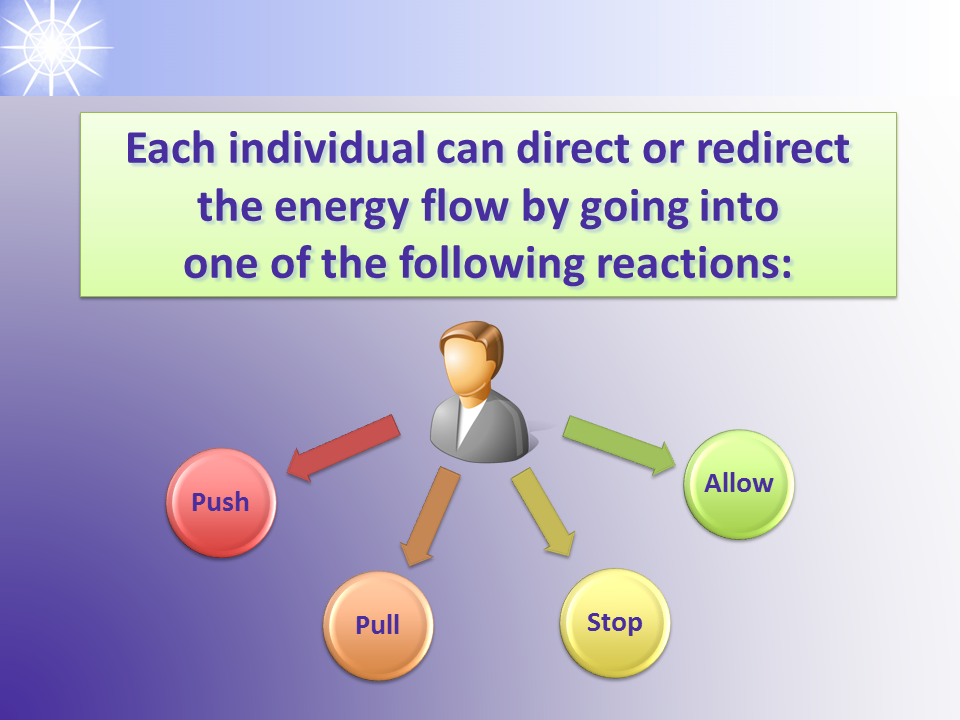
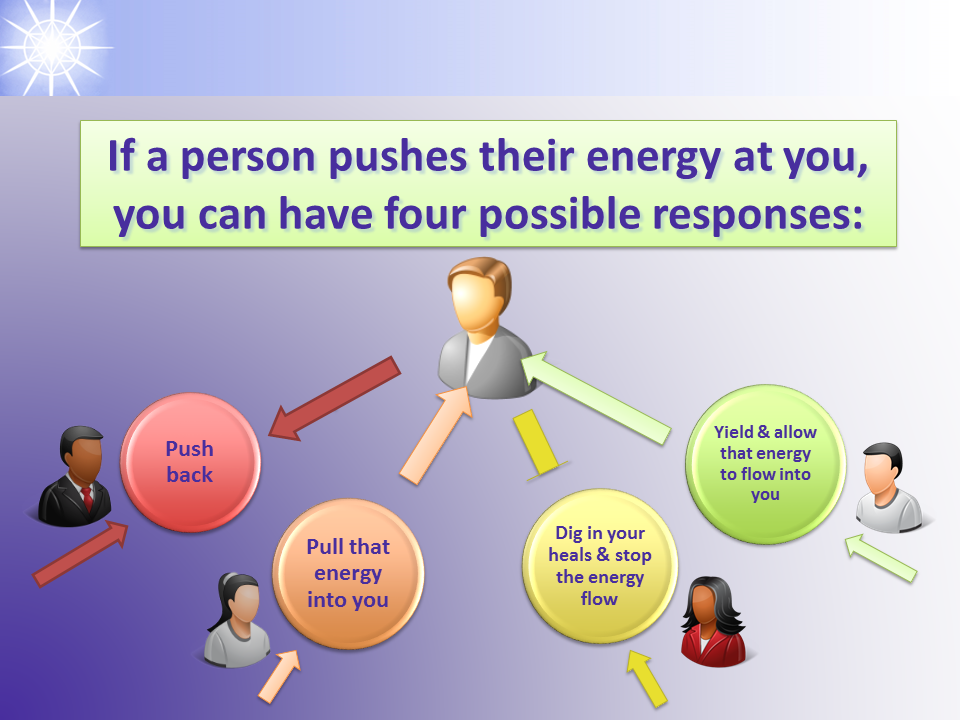

The most common reactions to the pushing person are to push back or stop the energy flow, and the most common reactions to the pulling person are to stop the energy flow or allow your energy to flow into them.
Counter-Transference
Counter-transference is the therapist having transference on the client. The therapists feelings towards the client may be a redirection of their own past relationships, resulting in an emotional entanglement with the client.
It is helpful in a relationship to make the individual feel safe. As they feel safe, they can begin to let down their defenses, which will decrease projection and distortion and increase communication. It will also allow any form of physical healing modality to penetrate deeper into their physiology, resulting in an improved healing response by the body to that modality.
To give in to a persons unconscious demand that you agree with their distorted view of the world, or to allow them to take advantage of you through their defense, only serves to strengthen their defense. Although you have a primary character structure, you may find yourself using different situations. Generally speaking, the schizoid goes into ALLOW and “withdraws out of the body,” effectively creating a “stop,” the masochist goes into STOP and “withdraws out of the body,” the oral goes into PULL, the psychopath goes into PUSH, and the rigid goes into ALLOW.

Schizoid: When dealing with a schizoid indiviual or a person using a schizoid defense of withdrawal, you will notice a vacant look in their eyes or their eyes will be closed. They are dissociating out of fear. Your challenge is to make them feel safe and connect with you.
However, what is your negative reaction when this person withdraws and is not present with you? Do you get angry because they are not paying attention to you, and go into PUSH? If so, they go into STOP, become more fearful, and withdraw further. They will be even harder to reach on your next interaction because of your psychopathic response to their schizoid defense. Alternatively, do you feel abandoned by them and energetically try to grab them with a PULL response? Again, this oral response makes them withdraw further.
If you go into STOP and just wait, or go deep inside yourself in a masochistic defensive reaction to the schizoid, then you miss each other and no communion occurs.
The rigid response would be to deny the person has left and carry on your instructions as if you were being heard. This ALLOW mode wastes your time.
If you yourself are schizoid, you may be seduced into dissociating yourself, and then no one is grounded. Little to nothing gets accomplished in the interaction.
A favorable response to the schizoid is to remain very calm, avoid direct eye contact, and ground oneself firmly. Do not focus your mind on one thing, as this will be perceived as threatening.

Oral: You will recognize the oral defense in a person when they act helpless. They will be needy and hypochondriacal. They may speak softly to suck you in, or go out of their way to make eye contact so they can PULL on you.
If their sucking your energy makes you angry, you may PUSH negative energy at them. This psychopathic response of attacking them will just make them feel worse about themselves. They will collapse and become even more helpless.
You may respond by going into STOP so they cannot get your energy. Perhaps you stop listening and avoid them, retriggering their wound of abandonment and their defense.
If oral yourself, you may feel abandoned and go into PULL. They will either pull harder, or collapse.
A rigid response to the oral individual would involve going into denial and an ALLOW mode. Allowing them to PULL you in, and suck your energy.
If you are a caretaker, you may pour energy into others, as they have passively demanded from you. Do you agree that they are helpless, but you have a lot of energy to give them? This may seem to work initially, but when all you give is still not enough, their negative belief system is strengthened and your energy is depleted.
You may have a schizoid response to their orality, withdrawing your energy so there is none present for them to suck. Again, they experience abandonment and either suck harder or collapse.
You want to avoid direct eye contact and having your energy sucked from the solar plexus by turning sideways from the individual. Make them responsible for their own healing, and avoid the temptation to do it for them. Set good boundaries around your time from the onset, as they will struggle with there never being enough time for them. As always, ground and center yourself.
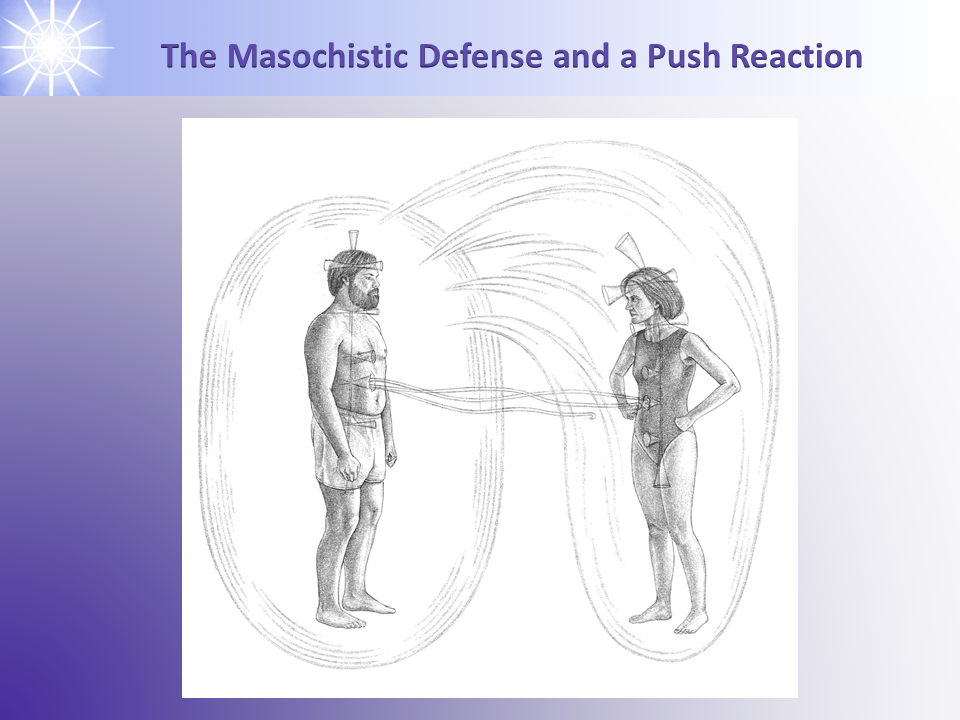
Masochistic: The individual who is a masochistic character type will be very serious. Their conversation is full of pauses and they feel their condition to be a heavy burden. They may talk of “our problem” rather than “my problem.” They want your advice, but your suggestions are wrong and will not help. There is a sense of inertia as they reject your recommendations, or simply decide not to follow them.
What is your response to a person who provokes you, rejects your help, and then blames you when they do not get better? If you react with anger and PUSH rejecting energy at them, they withdraw deeper into themselves to avoid invasion and humiliation. Their fear is increased.
If their withdrawal deep inside themselves triggers your abandonment issue, you may respond by PULLING. This is what their parents did, resulting in a deeper retreat.
If you are masochistic yourself, then you will likely go into a STOP reaction, stopping your energy flow and withdrawing inside of yourself, so any communication is distant and based on shared negative belief systems regarding a controlling and unfair world. If you are in denial of their defense and go into ALLOW, pretending you are not being pulled in and then pushed away by the person, you will feel tired, helpless or confused yourself.
Or, you may go into a schizoid defense and dissociate, so they are deep within and you have left yourself.
For a favorable healing response to the masochist, others must be careful not to invade them and trigger their defense making them withdraw further inside. Respect their space and let them set the distance and boundary. Avoid solar plexus connection as you would with the oral type, but if they begin to feel safe and reach out, then connect with them in a way that is devoid of control. Do not finish their sentences for them no matter how long they pause as they formulate their ideas.
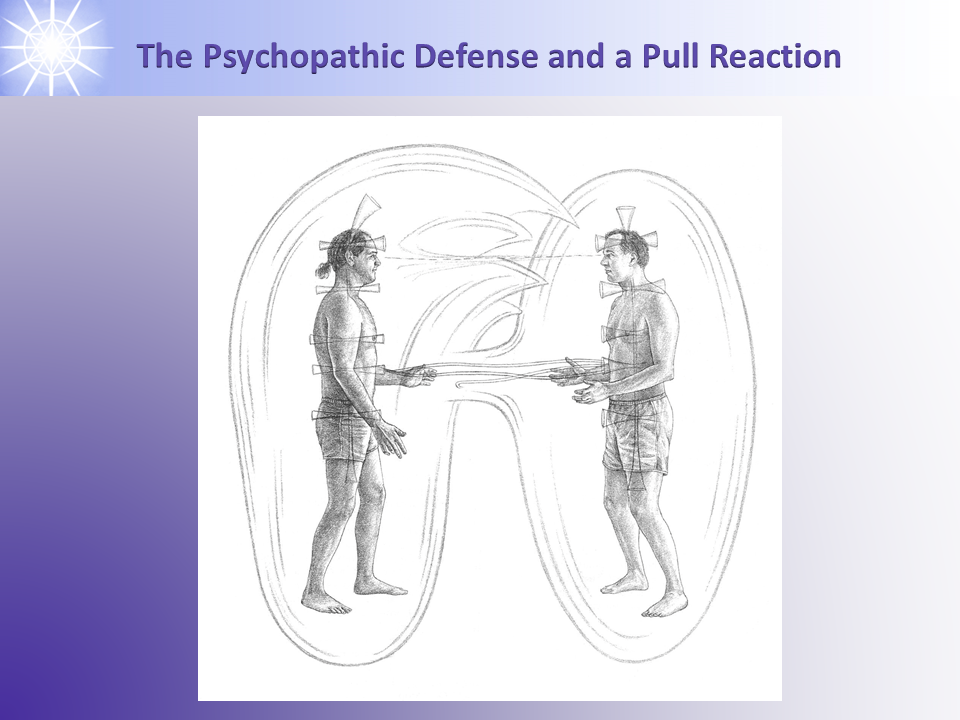
Psychopathic: The psychopath will try to pick a fight with you and prove you are wrong. They will be glad to let you work on them so you can get better and benefit from their critique of your work. Their fear of betrayal makes them control you in order to feel safe. If this makes you angry, and you go into the PUSH by fighting back, then things escalate and they get vicious like a cornered animal, as in the case of borderline personality disorder. If you feel abandoned, and try to grab on and PULL, they will become more aggressive to PUSH you away.
If you have a masochistic reaction to the psychopathic defense, then you will STOP your energy flow and go inside of yourself. Their response is to puff themselves up even more, and attack harder to reach and control you. The rigid’s response would be to deny the attack and go into ALLOW. Like the masochist’s response, the psychopath wins, you feel bad about yourself, and the person confirms their belief that the world is a battleground in which you are either a winner or a loser. And losers are bad, as the psychopath learned during childhood.
The schizoid may withdraw so as not to have to take their blame. Again, this will infuriate the psychopath into a more aggressive attack. It is best to agree with their black and white view of the world, and yet to argue with them proves their point.
A favorable response to the psychopath in transference with you would be to avoid eye contact, ground yourself, and stay centered within yourself to avoid attacking them back. Realize their attack is a projection on you and not based on anything you actually said. Rather than argue with them, listen passively until they are finished. Remember that they have self-hatred and denial of their own self-loathing. Tell them you trust them, stay calm, and try to accept them. After all, they see you as the aggressor who thinks they are bad.
Your willingness to let them rant at you makes them feel safe, and they can start giving up having to control you. If they believe they were heard, then they will begin to trust you.
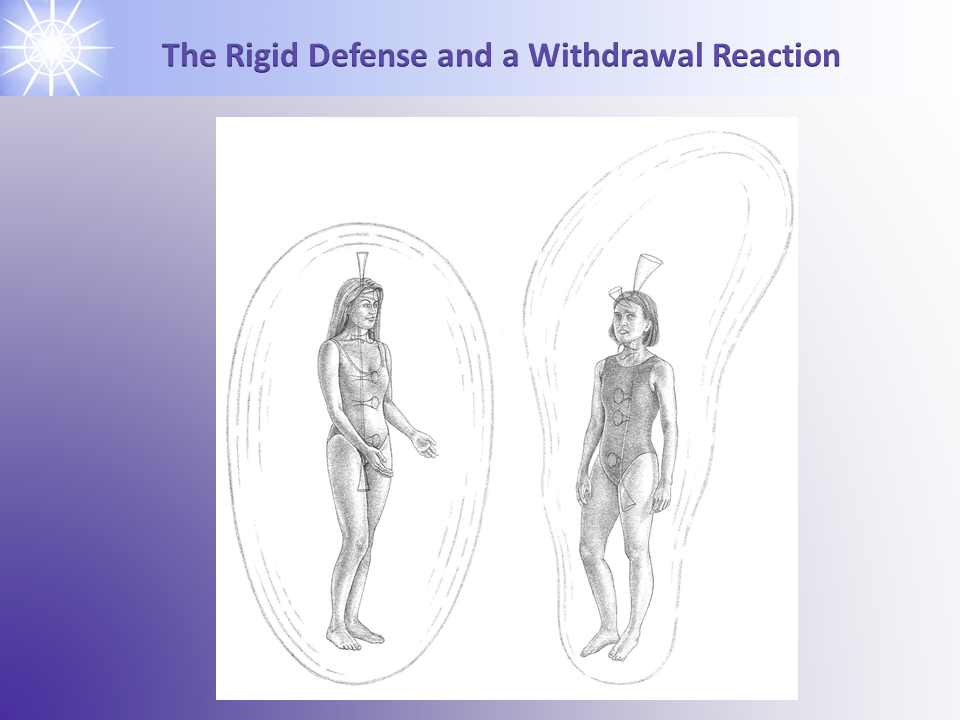
Rigid: The rigid character type developed from a denial of the negative inner psychological world in favor of a “perfect” outer physical world. In order to maintain the illusion of perfection, they control any affect of negative emotional response. Therefore, what goes on inside of them psychologically is “split off” from the outer world and the perceptions of others.
You can sense the lack of authenticity behind their facade. If this angers you and you go into PUSH, they may want to know what your problem is so they can help you. They can remain in denial by deflecting the conversation onto you.
The masochist’s response to the rigid is to STOP and withdraw inside to tune out the falseness of the conversation. The masochist may either pretend to be listening while thinking of something else, or just go inside and wait.
If you feel abandoned by the rigid, you will energetically grab onto them and PULL. They will retreat to strengthen their inner wall, deny your pulling, and become even more reasonable.
If rigid yourself, you may be comfortable with this person’s denial and go into ALLOW. You carry on a superficial conversation, and no communication or healing takes place.
The schizoid response to the rigid is to dissociate. If you are not present and communicating, then the inauthenticity of the rigid person is not felt and they appear to be perfectly reasonable.
The rigid has good boundaries, so you can get physically close to them without triggering any defenses. Ground and center yourself within your individuality, while holding a state of loving acceptance for their individuality.
Counter-Transference Scenario
Dr. Smith finds that he feels drained, tired and angry after working on his patient Ms. Jones. He struggles to end the visit while Ms. Jones feels she needs more time and more to be done.
Dr. Smith brings his dilemma to Dr. Johnson for supervision. Dr. Smith confides to Dr. Johnson that during prior testing he was found to be primarily a masochistic character type, with a secondary character type of rigid. In his Characterological evaluation of Ms. Jones, he found her to be primarily an oral character type.
Dr. Johnson has Dr. Smith recall how he feels towards the end of a session with Ms. Jones while holding the image of Ms. Jones in his mind. A strong muscle weakens. This weakness is abolished by therapeutic localization contact. While Dr. Smith holds the feeling, Dr. Johnson contacts each of the alarm acupoints associated with the 5 character types one by one. The weakness now is abolished with Dr. Johnson contacting CV12, confirming that Dr. Smith uses a masochistic character defense when triggered by Ms. Jones.
Dr. Johnson now begins to test Dr. Smith on the Masochistic Personal Declaratives adding in “when confronted by Ms. Jones.” A weakening of a strong muscle occurs with “I am OK with asserting for my freedom when confronted by Ms. Jones.” Now, Dr. Johnson adds on “when confronted by Ms. Jones' oral defense” and again there is weakening of the previously strong muscle. This affirms Dr. Smith’s prior diagnosis of Ms. Jones' orality.
Dr. Johnson now proceeds with esoteric kinesiology off the personal declarative, “I’m OK with asserting for my freedom when confronted by Ms. Jones’ oral defense,” and clears a trauma at age 2 involving his mother getting her needs met vicariously through 2-year-old Dr. Smith rather than her absent husband.
After clearing this trauma, Dr. Johnson retests the personal declarative and Dr. Smith now stays strong. “To Surround the Dragon” on Dr. Smith’s counter-transference with Ms. Jones, Dr. Johnson semantically challenges the remaining masochistic personal declarative. Upon weakening, esoteric kinesiology is repeated.
Dr. Smith finds that in future office visits with Ms. Jones he is able to set healthy boundaries and is no longer tired and angry afterwards. Ms. Jones is taking more responsibility for her own healing.
Esoteric Kinesiology Steps to clear Counter-Transference:
1. Evaluate the individual for character type.
2. Recall someone that triggered you and you suspect you have counter-transference with.
3. As you recall how this person made you feel, a strong muscle weakens.
4. This muscle strengthens with therapy localization of the emotional neurovascular points on the forehead. Disconnect the therapeutic localization contacts.
5. Now, while still holding the feeling, your practionioner contacts each of the alarm acupoints a
ssociated with the five character types. The alarm acupoint, which abolishes the weakness, correlates with the defense and/or transference on you.
6. Now, take the personal declaratives associated with that character type, and add in “confronted by” and the name of the person. “I am OK with asserting for my own freedom when confronted by Ms. Jones.” The strong muscle will weaken.
7. Then add on the name of the patient’s primary character defense which was previously determined in Step 1. There should still be weakening. If there was strengthening, then each of the remaining four character defenses could be added on until weakening confirmed the person’s defense that triggered you.
8. Remember that this procedure can work for you whether or not the person’s character type was properly evaluated, or whether or not the patient was in their primary or secondary character defense when you were triggered. If there is no weakness with the 1st personal declaratives, move onto the 2nd or 3rd personal declaratives under the defense you went into.
9. Once the client tests strong with the personal declarative, perform esoteric kinesiology to clear your counter-transference. Ideally, the original traumatic event will be at the development age associated with your character defense.
10. Semantically challenge the remaining personal declarative associated with the doctor’s characterological defense. Where there is weakness, perform esoteric kinesiology.
PATIENT MANAGEMENT SKILLS OR PHRASES FOUND HELPFUL WITH THIS PROCEDURE: Sometimes we are able to handle other’s defense systems and other times we find ourselves intolerant of their negative energetic defense interactions. Counter-transference could be defined as the practitioner’s projection on the client as a result of the practitioner’s response to the client’s defenses in lieu of practitioner’s own past wounds. As practitioner, your character type and the client’s characterological defense provides an understanding of the projections that will be triggered in you.
As practitioner, your character type and the patient’s characterological defense results in your energetic response to their energy flow. You may respond with push, pull, allow, or stop.
WHAT SOMEONE WHO USES THIS PROCEDURE CAN USUALLY EXPECT: In psychiatry and psychology, supervision is utilized to help practitioners get insight into their own counter-transference with a patient. Often the hardest person to see is ourselves. As you clear your counter-transference with your client, that client gains a feeling of safety. This results in their trusting you, and allows their defenses to drop. This will permit them to reveal more of themselves, and your work with them will go deeper. Both practitioner and client will benefit.
AVERAGE TIME TO DO THIS PROCEDURE: 15-30 minutes
